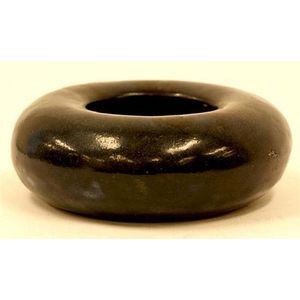Mahogany Chinese Chippendale Desk with Gilded Leather Top
An Edwardian mahogany Chinese Chippendale style desk, gilded leather insert to the top, two half drawers with decorative detail, unusual four pillar legs, with fretwork cross stretcher base, maker's name Edwards & Roberts stamped to one drawer. 122 x 60.5 x 75.5 cm.
You must be a subscriber, and be logged in to view price and dealer details.
Subscribe Now to view actual auction price for this item
When you subscribe, you have the option of setting the currency in which to display prices to $Au, $US, $NZ or Stg.
This item has been sold, and the description, image and price are for reference purposes only.
- Gilding - Gilding is a method of ornamentation whereby a thin sheet of gold metal is applied to items made of wood, leather, ceramics, glass and silver for decorative purposes.
For furniture including mirrors, the sheet of gold is usually applied over a coating of gesso. Gesso is a mixture of plaster of Paris and gypsum mixed with water and then applied to the carved wooden frames of mirrors and picture frames as a base for applying the gold leaf. After numerous coats of gesso have been applied, allowed to dry and then sanded a coat of "bole", a usually red coloured mixture of clay and glue is brushed on and allowed to dry, after which the gold leaf is applied. Over time parts of the gilding will rub off so the base colour can be seen. In water gilding, this was generally a blue colour, while in oil gilding, the under layer was often yellow. In Victorian times, gilders frequently used red as a pigment beneath the gold leaf.
Metal was often gilded by a process known as fire gilding. Gold mixed with mercury was applied and heated, causing the mercury to evaporate, the long-term effect of which was to kill or disable the craftsman or woman from mercury poisoning. The pursuit of beauty has claimed many victims, not the least of which were the artists who made those pieces so highly sought after today. - Mahogany - Mahogany is a dense, close grained red-coloured timber from the West Indies and Central America. It was first imported into Europe in the the early 18th century and its use continued through the 19th century. It was popular for furniture making because of its strength, the wide boards available, the distinctive grain on some boards, termed flame mahogany and the rich warm colour of the timber when it was polished.. The "flame" was produced where a limb grew out from the trunk of the tree, and this timber was usually sliced into veneers for feature panels on doors, backs and cornices.
Some terms used to describe mahogany relate to the country from which it originally came, such as "Cuban" mahogany, "Honduras" mahogany etc. However unless the wood has been tested the names assigned are more a selling feature, rather than a true indication of the timber's origin. - Edwardian - The Edwardian period of English furniture and decorative arts design is named for Edward VII (1841 ? 1910) who was King of the United Kingdom and the British Dominions and Emperor of India for the brief period from 1901 until his death in 1910. It follows the Victorian period, in turn was followed by the Art Nouveau and Art Deco styles. In Australia, designs of this period are also known as being in the Federation style.
- Fretwork - Pierced intricate decorative patterns, cut with a fine saw and generally found around the galleries of desk tops, open-hanging shelves and small tables.
In open fret, the timber is completely pierced, giving an appearance of great lightness and delicacy.
With blind fret, as seen in Chinoiserie styles of Chippendale, the fretwork is applied like a moulding to a solid panel. - Stretcher - A horizontal rail which connects the legs of stools, chairs, tables and stands, to provide stabilisation of the legs. A stretcher table is any table with a stretcher base. The term is usually applied to substantial farmhouse tables, although many cabinetmaker's pieces, such as sofa tables, also have turned stretchers.
- Signed or Stamped - A signed piece of furniture may mean that the maker has signed (and hopefully dated) the piece in the same way that we sign a cheque, but more likely, that it bears evidence of the name of the maker, wholesaler or retailer as a paper label, metal plaque, impressed into the timber or in later pieces after about 1880, stamped onto the timber with an ink stamp.
The 'signature' or stamp will always be in an unobtrusive position: under the top of a table, on the underside of the rails of a chair, inside a drawer or on the back.
The fact that a piece is 'signed' considerably enhances its value. Signed Australian furniture is extremely rare, and for imported furniture, it is a mark of quality of the item, as only the items by the top makers or retailers were 'signed'
This item has been included into following indexes:
Visually similar items

A green and gilt decorated metal floor lamp, French, circa 1940, with a white linen shade, 155 cm high, 49 cm wide (base)
Sold by
in
for
You can display prices in $Au, $US, $NZ or Stg.

Sideboard: Victorian flame mahogany three door sideboard. Height 152 cm, width 214 cm, depth 61 cm
Sold by
in
for
You can display prices in $Au, $US, $NZ or Stg.

A French brass and iron baker's stand. 210 cm high, 120 cm wide, 50 cm deep.
Sold by
in
for
You can display prices in $Au, $US, $NZ or Stg.

VI Eyre (1870-1956), a deep blue glazed earthenware bowl, signed VI Eyre 13 cm high
Sold by
in
for
You can display prices in $Au, $US, $NZ or Stg.
